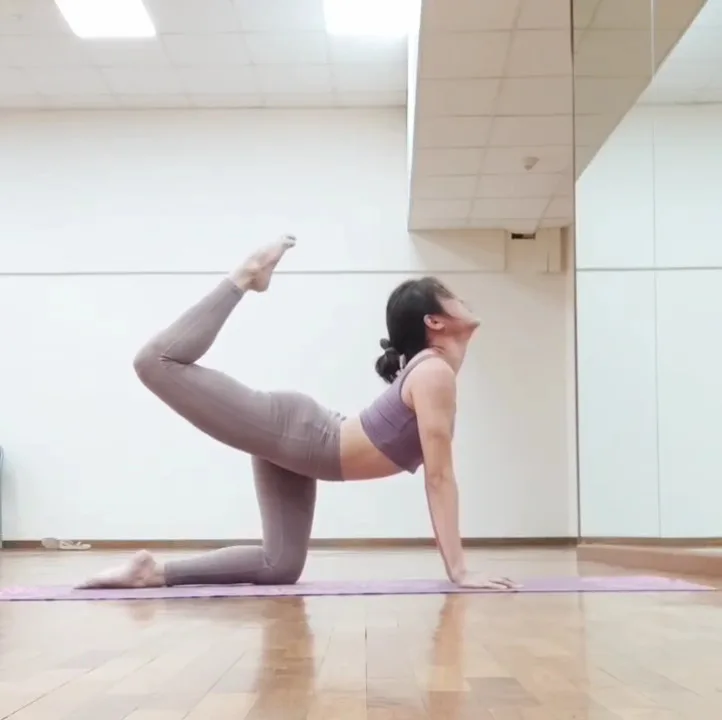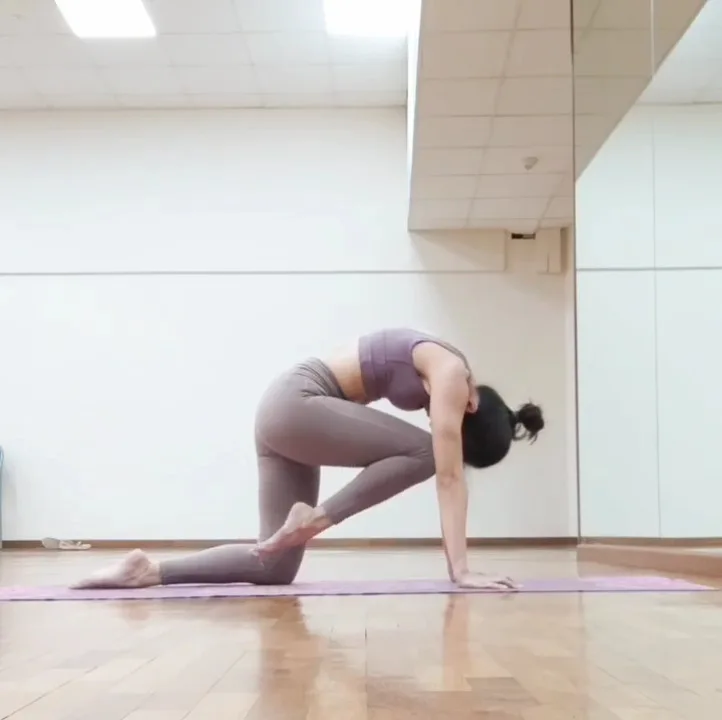Vyaghrasana, also known as Tiger Pose, strengthens the arms, shoulders, and leg muscles, while stretching the hip flexors, including the psoas and quadriceps.
Information
| Known as: | Vyaghrasana, Tiger Pose, Balancing Table Pose Variation |
| Sanskrit name: | व्याघ्रासन |
| IAST: | Vyāghrāsana |
| Pronunciation: | vya-GH-rah-sa-nuh |
| Type: | Backbend, balance, strength, stretche |
| Level: | Intermediate |
| Focus: | Core, arms, shoulders, legs |
| Total time: | 20 to 30 seconds |
| Drishti: | Nasagra (the tip of the nose) |
| Chakra: | Manipura Chakra (Solar Plexus Chakra), Manipura Chakra (Solar Plexus Chakra), Anahata Chakra (Heart Chakra), Svadhisthana Chakra (Sacral Chakra) |
| Indications: | Hip flexors, psoas, qquadriceps, arms, shoulders, leg muscles, core, spinal, abdominal, obliques, energize, invigorating, stress, focus, concentration, anxiety |
| Counterposes: | Balasana (Child’s Pose), Adho Mukha Svanasana (Downward-Facing Dog Pose), Marjaryasana-Bitilasana (Cat-Cow Pose), Uttanasana (Standing Forward Fold Pose), Savasana (Corpse Pose) |
| Preparatory poses: | Cat-Cow Pose (Marjaryasana-Bitilasana), Sphinx Pose (Salamba Bhujangasana), Cobra Pose (Bhujangasana), Bridge Pose (Setu Bandhasana), Downward-Facing Dog Pose (Adho Mukha Svanasana), Plank Pose (Phalakasana) |
| Follow-up poses: | Downward-Facing Dog Pose (Adho Mukha Svanasana), Extended Triangle Pose (Utthita Trikonasana), Camel Pose (Ustrasana), Sphinx Pose (Salamba Bhujangasana), Seated Forward Bend Pose (Paschimottanasana), Savasana (Corpse Pose) |
| Contraindications: | Severe Sciatica or Slipped Disc; Knee, Hip, Wrist, or Shoulder Injuries; Back Issues or Cervical Spondylitis; Pregnancy; Heart Condition; Recent Injuries to Hips, Neck, and Knees |
Meaning
The term “Vyaghrasana” is derived from Sanskrit, which consists of two words — Vyaghra + Asana:
- “Vyaghra” = “tiger”
- “Asana” = “pose” or “posture”
Combining these two words, “Vyaghrasana” can be translated as “Tiger Pose.” The name implies that the pose embodies qualities associated with the tiger, such as strength, focus, and grace. It reflects the shape and energy of a tiger’s movement, as practitioners mimic the stretching and arching of the animal’s back.
The name “Vyaghrasana” helps to evoke the essence of the asana and the intention behind its practice. It serves as a reminder to embody the qualities of a tiger—confident, strong, and centered—while performing the asana.
Benefits of Vyaghrasana (Tiger Pose)
Tiger Pose offers various physical, mental, and emotional benefits. It’s crucial to note that individual experiences may vary, and practicing Vyaghrasana should be approached mindfully and within one’s own physical capabilities.
Physical Benefits:
- Increased Spinal Flexibility: This asana involves a deep backbend, which helps to improve spinal flexibility and mobility. It stretches the entire length of the spine, promoting flexibility and preventing stiffness.
- Strengthened Core Muscles: The Tiger Pose engages the core muscles as you stabilize your body and lift the leg. Regular practice of this asana helps strengthen the abdominal muscles, including the rectus abdominis and obliques.
- Improved Balance and Coordination: Maintaining balance while performing this asana challenges your coordination and proprioception. Regular practice enhances your ability to balance and improves overall coordination.
- Strengthened Arms, Shoulders, and Legs: Holding the body weight and extending the leg behind in Vyaghrasana strengthens the arms, shoulders, and leg muscles. It provides an opportunity to tone and build strength in these areas.
- Stretched Hip Flexors: As the leg extends behind, the hip flexors, including the psoas and quadriceps, are stretched. This helps to release tension in the hip flexors and improves hip mobility.
Mental and Emotional Benefits:
- Increased Mind-Body Connection: Practicing Vyaghrasana requires focus and concentration on the body’s alignment and movements. This cultivates a stronger mind-body connection, promoting mindfulness and body awareness.
- Energizing and Invigorating: The backbend nature of the asana can help to energize the body and awaken the mind. It stimulates the nervous system and helps to alleviate fatigue and lethargy.
- Stress Relief: Engaging in the physical practice of yoga, including Vyaghrasana, promotes stress relief and relaxation. The focused breathing and mindful movement during the asana can calm the mind and reduce anxiety and stress.
- Increased Confidence and Self-Empowerment: As you progress in your practice of Tiger Pose and achieve greater strength and flexibility, it can enhance your confidence and self-esteem. Accomplishing challenging asana1qqs like Vyaghrasana instills a sense of accomplishment and empowerment.
- Improved Focus and Concentration: The concentration required to maintain balance and alignment in this asana helps to improve focus and concentration. Regular practice can carry over into daily life, enhancing productivity and mental clarity.
Vyaghrasana (Tiger Pose) Practice Guide


Vyaghrasana (Tiger Pose) involves a combination of a backbend and a balancing position.
In this asana, the practitioner starts on all fours, with the hands and knees on the mat. The spine is then gently arched upward, creating a backbend, while one leg is extended backward and lifted up towards the head. The extended leg is further bent at the knee, and the head is turned upward, looking towards the ceiling.
The step-by-step instructions, common mistakes, modifications, variations, precautions, and contraindications of this yoga asana are giving below.
Step-by-step Instructions
- Assume the cat pose (Marjariasana) by aligning your gaze forward and allowing your body to relax.
- Proceed by lowering your back and extending your right leg outwards. Swing it upward.
- Next, flex your right knee and lift your head to gaze at the ceiling. Elevate your bent right leg even higher, pointing the sole towards the back of your head.
- Maintain this position while holding your breath.
- Following that, straighten your bent right leg and swing it beneath your hips. Simultaneously, lower your head, allowing your forehead to touch the right knee while creating a gentle curve in your upper back.
- Stay in this position and exhale, holding your breath outside for a few seconds.
- Then, bring your leg back, extend it, and gently stretch. Finally, lower your right knee to the floor, returning to the initial Marjariasana posture.
- Repeat the same sequence with the left leg in a similar manner.
Common Mistakes
Common mistakes in performing Vyaghrasana can occur due to improper alignment or lack of awareness. Developing body awareness, engaging the core, maintaining an open chest, and breathing consciously are key elements to perform the asana correctly and safely.
However, the common mistakes of Tiger Pose are explained below:
- Lack of core engagement: Many people fail to engage their core muscles during Vyaghrasana, resulting in a sagging or collapsing lower back. This can happen when there is a lack of awareness or weak core muscles. Engaging the core is crucial for maintaining stability and preventing strain on the lower back.
- Rounded shoulders and hunched back: Some individuals tend to round their shoulders and hunch their back while performing Tiger Pose. This may be due to poor posture habits or tightness in the chest and shoulders. It’s crucial to actively roll the shoulders back and open the chest to maintain proper alignment.
- Overarching the neck: Another common mistake is overextending or compressing the neck by lifting the head too high or dropping it too low. This can strain the neck and disrupt the flow of energy. It’s crucial to keep the neck in line with the spine, maintaining a natural extension without excessive tension.
- Unstable base and improper leg placement: Improper leg placement can make the asana unstable. Placing the hands too far forward or backward and not aligning the wrists with the shoulders can affect balance. Additionally, not extending the lifted leg straight behind and maintaining a proper alignment with the spine can compromise the integrity of the asana.
- Holding the breath: Many people tend to hold their breath while performing Vyaghrasana, which can create tension and restrict the flow of energy. It is essential to breathe deeply and consciously throughout the asana to enhance relaxation and stability.
Modifications and Variations
Modifications and variations of Vyaghrasana can be beneficial to accommodate different levels of flexibility, strength, and individual needs. It’s crucial to choose the modification or variation that feels appropriate for your body and consult with a qualified yoga instructor/teacher for guidance and support.
However, the modifications and variations of Tiger Pose are explaining below:
- Knee-to-Chest Variation: Instead of extending the lifted leg straight behind, you can bring the knee toward your chest. This modification helps to reduce strain on the lower back and provides a gentler stretch for individuals with limited flexibility or lower back issues.
- Supported Hands Variation: If you have wrist or shoulder discomfort, you can modify by performing the asana with your hands supported on yoga blocks or a bolster. This modification reduces the weight and pressure on the wrists and shoulders while still allowing you to experience the benefits of the asana.
- Wall Support Modification: For individuals who struggle with balance or stability, practicing Vyaghrasana with the support of a wall can be helpful. Stand facing the wall, with your hands resting on the wall at shoulder height. Extend one leg behind you and perform the asana while utilizing the wall for support. This modification provides stability and allows you to focus on alignment and strengthening without the fear of falling.
- Dynamic Variation: To add an element of dynamic movement and challenge, you can incorporate a “tiger crawl” motion. Begin in the traditional Tiger Pose position, and then move forward by extending the lifted leg and opposite arm forward simultaneously. This variation increases core strength, coordination, and overall engagement.
- Advanced Variation: For those looking for a more intense and advanced variation, you can incorporate a “Tiger Push-up” into the pose. From the traditional Tiger Pose position, lower your body into a push-up position, and then push back up to return to the starting position. This variation adds an element of upper body strength and increases the challenge of the asana.
Precautions and Contraindications
Consider precautions and contraindications, which are essential when practicing Vyaghrasana. They help ensure safety and prevent further injury or discomfort. However, the specific precautions and contraindications for different conditions of this asana are explaining below:
1. Severe Sciatica or Slipped Disc
If you are experiencing severe sciatica or have a slipped disc, it is crucial to avoid Tiger Pose. This pose involves back extension, which can aggravate these conditions and cause increased pain or further injury. It’s crucial to prioritize healing and consult with a healthcare professional for appropriate exercises and modifications.
2. Knee, Hip, Wrist, or Shoulder Injuries
Individuals with injuries in the knees, hips, wrists, or shoulders should approach Vyaghrasana with caution. This asana requires stability and strength in these areas. If you have any recent injuries or ongoing pain in these regions, it’s recommended to avoid or modify the asana to avoid exacerbating the condition.
3. Back Issues or Cervical Spondylitis
If you have existing back issues or cervical spondylitis, it’s important to approach the asana cautiously. The asana involves spinal extension, which can strain the back or neck. It’s advisable to consult with a healthcare professional or an experienced yoga instructor/teacher to determine if this this asana is suitable or if modifications are needed.
4. Pregnancy
Pregnant individuals should avoid practicing Tiger Pose, especially as the pregnancy progresses. The pose involves pressure on the abdomen and can potentially affect the stability of the pelvis. It’s recommended to focus on prenatal yoga exercises specifically designed for the needs and safety of pregnant individuals.
5. Heart Condition
Vyaghrasana is an intense asana that increases heart rate and requires physical exertion. Individuals with heart conditions should exercise caution or avoid the asana altogether. It’s crucial to prioritize heart health and consult with a healthcare professional for appropriate exercises and modifications.
6. Recent Injuries to Hips, Neck, and Knees
If you have experienced injuries to the hips, neck, or knees in the past few months, it’s crucial to allow sufficient time for healing and avoid putting additional strain on these areas. Modifications or alternative asanas may be more suitable to avoid exacerbating the injuries.














